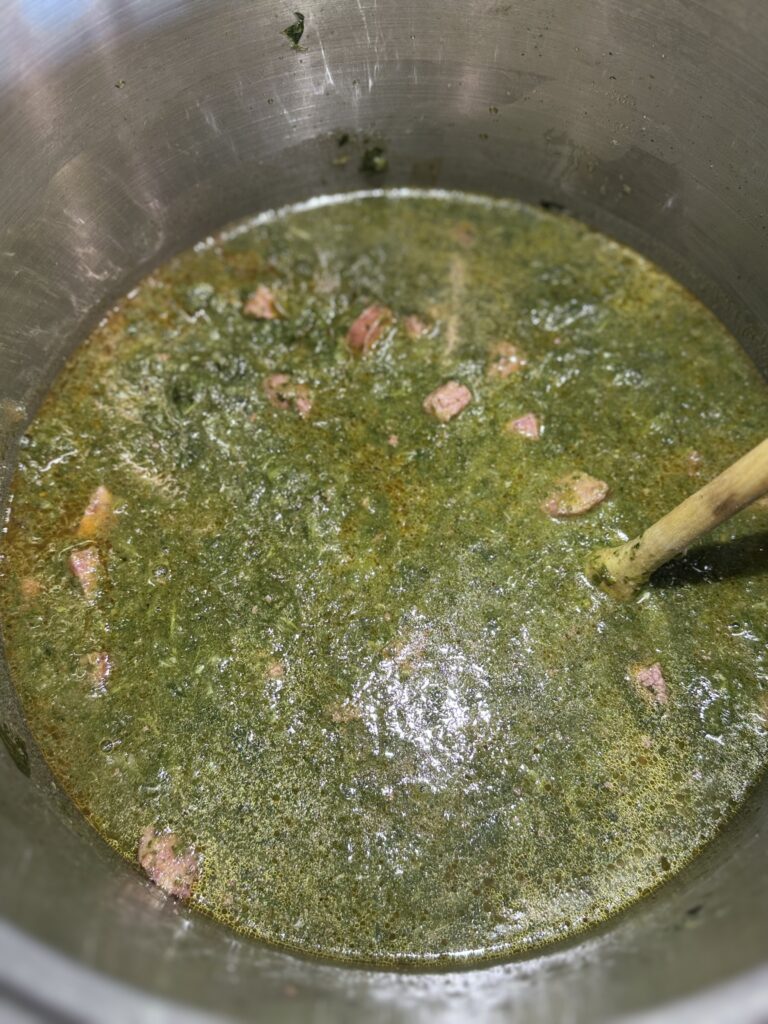Being a proud New Orleanian, Gumbo Z’Herbs holds a special place in my heart. I recently visited Lucille’s in Houston, and their gumbo reminded me of home so much that I couldn’t resist recreating it myself. The blend of greens and meats, simmered to perfection, always makes me feel right at home. Each bite of this recipe brings a little bit of that Dooky Chase’s magic into my kitchen. It’s like a comforting hug from my hometown, packed with all the incredible flavors we’re known for.

Gumbo Z’Herbs is described as a dish that captures the essence of New Orleans cooking. This gumbo was a staple at Dooky Chase’s Restaurant, where the legendary Leah Chase, known as the “Queen of Creole Cuisine,” perfected this recipe. Dooky Chase’s has long been celebrated for its contribution to Creole food culture, and Gumbo Z’Herbs was one of their signature dishes. The greens in this gumbo are more than just an ingredient; they represent the heart and soul of New Orleans, steeped in tradition and love.

The History of Gumbo Z’Herbs
Gumbo Z’Herbs is a classic Creole dish with roots that run deep in New Orleans. This gumbo celebrates the rich flavors of greens like collard, mustard, and turnip. “Gumbo Z’Herbs” literally means “herb gumbo,” highlighting those fresh, vibrant greens.
The origins of Gumbo Z’Herbes can be traced back to the influence of French, Spanish, and African culinary practices in Louisiana. Historically, this dish was popular during Lent, a period when Catholics traditionally abstained from eating meat. The rich, flavorful gumbo made use of a variety of greens—such as collard, mustard, and turnip greens—along with a selection of smoked meats to create a satisfying and hearty meal.
For Creoles, the use of greens in gumbo is more than just a recipe; it’s a representation of the importance of utilizing available resources and the deep connection to the land. The greens symbolize the abundance of local produce, while the smoked meats reflect the practice of preserving food in a region with a strong tradition of cooking with what’s on hand.

Gumbo Z’Herbes: A Symbol of Community and Tradition
Gumbo Z’Herbes is more than just a meal; it’s a symbol of community and tradition in New Orleans. Its preparation is often a communal activity, with families and friends coming together to cook and share this flavorful gumbo. The dish exemplifies the spirit of Creole cooking—where tradition, creativity, and resourcefulness come together to create something truly special.
In essence, Gumbo Z’Herbes is a testament to the rich cultural heritage of New Orleans. Its history reflects a blend of influences and a deep-rooted appreciation for the land and its bounty. As you savor each spoonful, you’re not just enjoying a delicious meal but also partaking in a storied tradition that has been cherished for generations.

Why This Recipe Works
This recipe works like a charm because it brings together all the best parts of a classic gumbo. The earthy greens meld beautifully with the rich meats and the roux, creating a gumbo that’s both hearty and full of flavor. Pureeing the greens ensures they’re perfectly blended into the gumbo, giving it a smooth texture while keeping that robust taste we all love. It’s a tried-and-true method for a gumbo that’s always a hit.

Step 1: Discard any wilted, yellow, or damaged parts of all the greens. Wash the leaves by swirling them in a sink full of cold water, separating them and giving them plenty of room to soak for a few seconds. Remove the leaves and place in a colander, rinse the sink, refill with fresh water, and repeat the washing process until all the dirt and grit have been removed. Drain the leaves in a colander.
Step 2: Put all the green in 2 very large pots, such as 12-quart stockpots, so the leaves won’t be overcrowded as they cook. Divide the onions and garlic between the pots. Add enough water to each pot to cover the greens and bring to a gentle boil over medium-high heat. Reduce the heat to medium and continue boiling, uncovered, for 30 minutes, stirring occasionally. Remove the pots from the heat.


Step 3: Cut the smoked sausage, ham, stew meat, and brisket into bite-size pieces and combine them all in a large bowl. Cut the chorizo into bite-size pieces and spread in a single layer in a large skillet. Set aside.
Step 4: When the greens have boiled for 30 minutes, strain through a colander set over a large heatproof bowl or a saucepan, reserving both the greens and the cooking liquid separately.
Step 5: In another 12-quart pot, combine the reserved meats with 2 cups of the reserved cooking liquid from the greens. Bring to a simmer over medium heat and cook, uncovered, for 15 minutes, stirring occasionally. Remove from the heat and set aside.

Step 6: Place the skillet of chorizo over medium-high heat and cook until most of the fat is rendered from the meat, 15 to 20 minutes, turning the pieces at least once. Remove from the heat and use a slotted spoon to transfer the chorizo to paper towels to drain. Pour the fat in the skillet into a heat-proof glass measuring cup; if the fat doesn’t measure about 1/3 cup, add vegetable oil to make up the difference, or if it is more than about 1/3 cup, pour off until there is 1/3 cup in the measuring cup.

Step 7: Make the roux. Return the 1/3 cup fat to the skillet and heat over medium heat for about 1 minute. Add the flour, stirring until thoroughly blended with the fat. Let the roux cook gently for 3 to 4 minutes, stirring and scraping the pan bottom almost constantly. (This will cook the raw flour taste out of the roux but should not be enough to brown the roux, although it’s okay if it browns slightly). Remove from the heat and stir for another minute or 2 to help the roux cool without browning from the residual heat. Set aside.
Step 8: Working in batches, put the drained greens in a food processor and process to a smooth puree. add some of the reserved cooking liquid if needed to thin the puree for ease of processing. Make sure to reserve 2 quarts of the cooking liquid for finishing the dish. Set aside the pureed greens.


Step 9: Return the pot of meats to a simmer. Gradually add the roux to the pot, stirring until completely dissolved into the liquid. Add the pureed greens and 2 quarts of the reserved cooking liquid. Bring to a simmer, stirring often and scraping the pan bottom clean as you stir.
Step 10: Simmer for 20 minutes, then add to the gumbo the browned chorizo, the salt, thyme, and cayenne, stirring well. Continue simmering until all the flavors have married, until the grease separates and starts to float to the top, about 40 minutes more, adding more cooking liquid from the greens (or water) if needed. Stir in the file powder and remove from the heat. If making ahead, don’t add the file powder until you are reheating the gumbo just before serving)
Step 11: Spoon the rice into large individual bowls. Spoon the gumbo over the rice and serve immediately. Add hot sauce if desired.

✅ Quick Tips: Read the recipe in its entirety before you start cooking. This will help you understand the ingredients, steps, and timing involved, and allow you to prepare any necessary equipment or ingredients beforehand.

Gumbo Z’herbes
Ingredients
Nutritional Value
Nutritional Value
Servings 12
- Amount Per Serving
- Calories 454kcal
- % Daily Value *
- Total Fat 32.2g50%
- Saturated Fat 11.8g60%
- Trans Fat 0.9g
- Cholesterol 101mg34%
- Sodium 1015mg43%
- Potassium 762mg22%
- Total Carbohydrate 15.2g6%
- Dietary Fiber 4.8g20%
- Sugars 3.6g
- Protein 27.4g55%
- Vitamin A 5940 IU
- Vitamin C 41.3 mg
- Calcium 137 mg
- Iron 3.9 mg
* Percent Daily Values are based on a 2,000 calorie diet. Your daily value may be higher or lower depending on your calorie needs.










